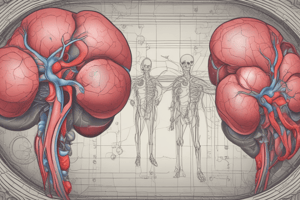Podcast
Questions and Answers
What percentage of the total cardiac output is received by the kidneys?
What percentage of the total cardiac output is received by the kidneys?
- 30-35%
- 10-15%
- 20-25% (correct)
- 40-45%
What is the main function of the renal corpuscle?
What is the main function of the renal corpuscle?
- Secretion and excretion
- Filtration and reabsorption
- Reabsorption only
- Filtration only (correct)
What is the role of the loop of Henle in the nephron?
What is the role of the loop of Henle in the nephron?
- Tubular reabsorption and secretion
- Reabsorption and secretion
- Filtration and reabsorption
- No specific role (correct)
What is the primary function of the kidney in terms of blood pressure regulation?
What is the primary function of the kidney in terms of blood pressure regulation?
What is the structure that collects urine from the calyces?
What is the structure that collects urine from the calyces?
What is the hormone produced by the kidneys that stimulates red blood cell production?
What is the hormone produced by the kidneys that stimulates red blood cell production?
What is the process by which the kidneys produce a filtrate?
What is the process by which the kidneys produce a filtrate?
What is the function of the kidneys in terms of vitamin D?
What is the function of the kidneys in terms of vitamin D?
Flashcards are hidden until you start studying
Study Notes
Structure
- The kidney is a paired organ, with one located on each side of the spine in the retroperitoneal space.
- Each kidney is surrounded by a fibrous capsule and is divided into the following regions:
- Cortex: outer layer, contains nephrons (functional units of the kidney)
- Medulla: inner layer, contains renal pyramids (collecting ducts and blood vessels)
- Renal pelvis: funnel-shaped structure that collects urine from the calyces (cup-like structures)
Functions
- Excretion: remove waste and excess substances from the blood, including urea, creatinine, and water
- Regulation of electrolytes: maintain homeostasis of electrolytes like sodium, potassium, and calcium
- Blood pressure regulation: control blood pressure through the renin-angiotensin-aldosterone system
- Erythropoiesis: produce erythropoietin, a hormone that stimulates red blood cell production
- Vitamin D activation: convert vitamin D into its active form, calcitriol
Blood Supply
- The kidneys receive about 20-25% of the total cardiac output
- Renal arteries branch off from the abdominal aorta and divide into smaller segments
- Renal veins drain into the inferior vena cava
Nephrons
- Functional units of the kidney, responsible for filtration, reabsorption, and secretion
- Each nephron consists of:
- Renal corpuscle (Bowman's capsule and glomerulus)
- Proximal convoluted tubule (PCT)
- Loop of Henle
- Distal convoluted tubule (DCT)
- Collecting duct
Filtration and Urine Formation
- Glomerular filtration: the process by which the glomerulus filters the blood, producing a filtrate
- Tubular reabsorption: the process by which the PCT and DCT reabsorb water, electrolytes, and nutrients back into the bloodstream
- Tubular secretion: the process by which the PCT and DCT secrete waste and excess substances into the filtrate
- Urine formation: the final product of the filtration and reabsorption processes, containing waste and excess substances.
Kidney Structure
- The kidney is a paired organ located on each side of the spine in the retroperitoneal space, surrounded by a fibrous capsule.
- Each kidney is divided into three regions: cortex, medulla, and renal pelvis.
Cortex
- Outer layer of the kidney containing nephrons (functional units).
Medulla
- Inner layer of the kidney containing renal pyramids (collecting ducts and blood vessels).
Renal Pelvis
- Funnel-shaped structure that collects urine from the calyces (cup-like structures).
Kidney Functions
- Excrete waste and excess substances from the blood, including urea, creatinine, and water.
- Regulate homeostasis of electrolytes like sodium, potassium, and calcium.
- Control blood pressure through the renin-angiotensin-aldosterone system.
- Produce erythropoietin, a hormone that stimulates red blood cell production.
- Convert vitamin D into its active form, calcitriol.
Blood Supply
- The kidneys receive 20-25% of the total cardiac output.
- Renal arteries branch off from the abdominal aorta and divide into smaller segments.
- Renal veins drain into the inferior vena cava.
Nephron Structure
- Consists of renal corpuscle (Bowman's capsule and glomerulus).
- Consists of proximal convoluted tubule (PCT).
- Consists of loop of Henle.
- Consists of distal convoluted tubule (DCT).
- Consists of collecting duct.
Filtration and Urine Formation
- Glomerular filtration: the process by which the glomerulus filters the blood, producing a filtrate.
- Tubular reabsorption: the process by which the PCT and DCT reabsorb water, electrolytes, and nutrients back into the bloodstream.
- Tubular secretion: the process by which the PCT and DCT secrete waste and excess substances into the filtrate.
- Urine formation: the final product of the filtration and reabsorption processes, containing waste and excess substances.
Studying That Suits You
Use AI to generate personalized quizzes and flashcards to suit your learning preferences.




